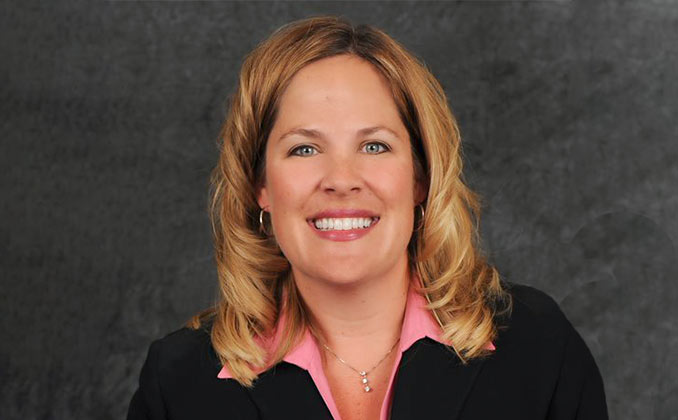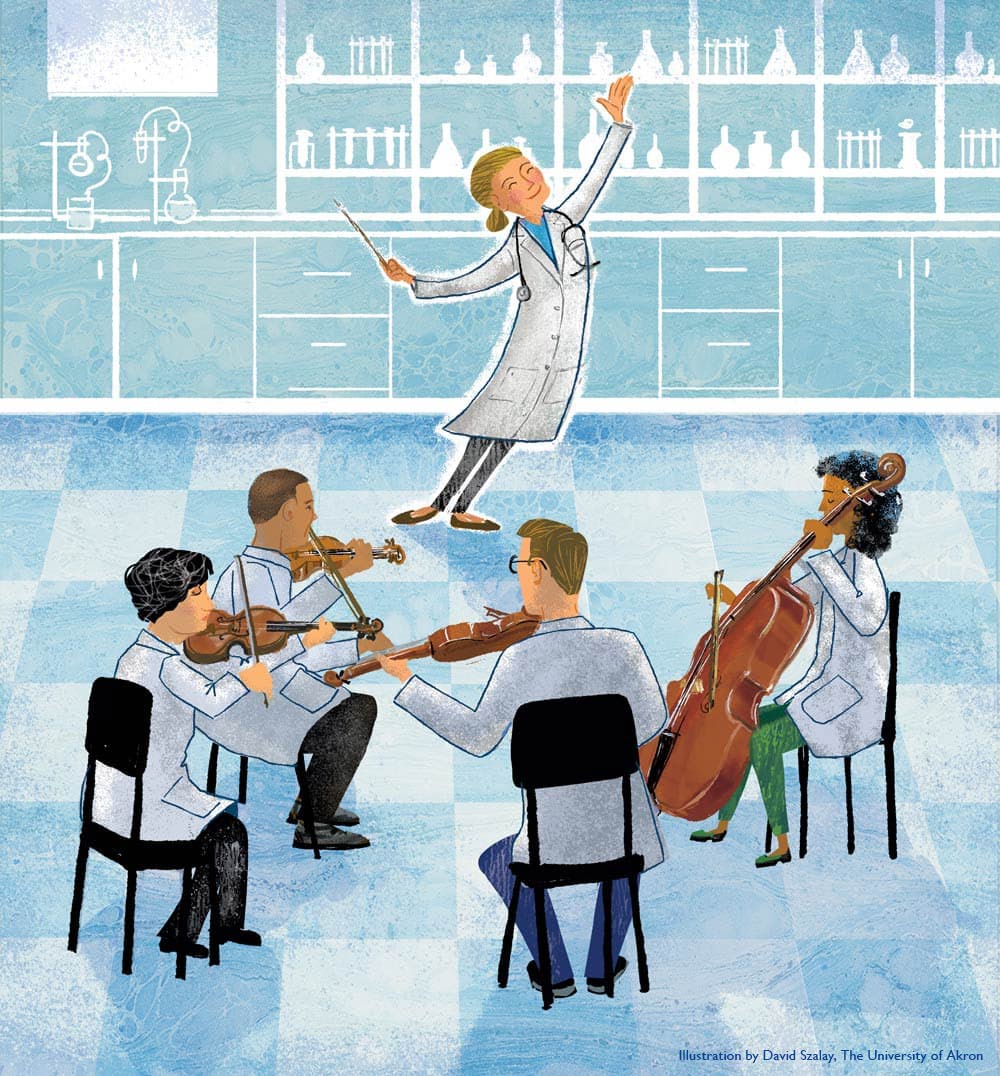Ignite | Fall 2022
The Interprofessionalist: Michelle Cudnik
BY RODERICK L. INGRAM SR.

Michelle Cudnik, Pharm. D., BCACP
Health care teams are like orchestras. When a single member is not able to practice or perform at the top of their skillset, outcomes aren’t optimized. The composition isn’t as good as it could be.
When he was once relegated to a role that was far less than his unique talents could offer, Wolfgang Amadeus Mozart remarked that it was "too much for what I do, too little for what I can do."
Pharmacists can perhaps relate to one of the world’s greatest composers. Mozart’s point of contention — in addition to his compensation — was about not being fully respected and used to the greatest extent of his training and capabilities.
Referring to an encounter she had with a physician as her “best [interprofessional experience] story ever,” Michelle Cudnik, Pharm. D., BCACP, a clinical ambulatory care pharmacist at Summa Health, describes it quite vividly.
“You know, interprofessional training and practice was still kind of an untapped territory at Summa. I had been here for maybe three days and one of the docs was seeing a patient. And she said, ‘you know, this patient's blood pressure is really elevated. I don't think he's taking his medications. Would you mind going in and talking to him about it?’” Dr. Cudnik recalled. “I said ‘no, not at all, would love to.’

“So, I went in and I talked with the patient, went through medications and asked a lot of questions. Then I came out and said… ”
Dr. Cudnik: Well, actually he's got orthostatic hypertension [low blood pressure resulting from standing after sitting or lying down].
Physician [giving Dr. Cudnik a strange look]: How do you know that?
Dr. Cudnik: Well, you know, I took his blood pressure when he was laying down and took his heart rate; I sat him up, then I took his blood pressure and took his heart rate; I then stood him up.
Physician: Well, how did you do that?
Confused by the questioning, Dr. Cudnik began describing how she used the exam table and her sphygmomanometer… then realized that “how did you do that?” wasn’t really what the physician wanted to know.
The physician was really asking: How did a pharmacist know how to complete this physical exam?
That encounter was about 17 years ago.
But Dr. Cudnik says that it serves as a reminder of how far health care has come. “Our ambulatory care clinic at Summa now has a social worker, behavioral health, nurse practitioners, a pharmacist — all embedded in this clinic. And it’s great that we all learn the roles that others can play.”
TWO DECADES IN THE MAKING
While pharmacists and their patient care services are not included in the Medicare Part B section of the Social Security Act, things are getting better. According to the National Alliance of State Pharmacy Associations, 167 bills pertaining to pharmacist scope of practice, payment for pharmacist-provided patient care services or the designation of pharmacists as providers were introduced in 2022 in 38 states.
But it’s been about 20 years since the Doctor of Pharmacy (Pharm.D.) degree became mandatory for prospective pharmacists in the U.S. Many pharmacists, though trained to provide patient care, are still either not allowed to practice at the top of their license or do not receive reimbursement even when they provide patient-care services.
But at Summa Health, like many other clinical settings, things are different.
Dr. Cudnik noted, “Here at Summa, interprofessional team-based care is not new. For instance, our pharmacy residency program is nearly 20 years in, and we've had pharmacy residents right alongside the medical residents. So, I haven't had many questions like, what are you doing here? Or why do they need a pharmacist in the clinic?”
Dr. Cudnik is the Post-graduate Year Two (PGY2) Residency Program Director in Ambulatory Care at Summa Health — or as she says, “I'm a clinical pharmacist in the ambulatory care setting.”
As a shared faculty member with NEOMED and Summa, Dr. Cudnik has the distinction of being the first faculty member hired by the College of Pharmacy.
She has relinquished some of her administrative responsibilities to spend the majority of her time precepting in the clinical arena. She still does some teaching but the extra time allowed her to start the PGY-2 ambulatory care pharmacy residency program six years ago.
LEADING THE CHARGE TO TRAIN FUTURE PHARMACISTS
First NEOMED College of Pharmacy faculty member.
First ambulatory care pharmacist with Summa.
First shared faculty member for interprofessional education (IPE).
With existing pharmacy colleges across the country preparing for new accreditation standards for a Doctor of Pharmacy degree and fledgling schools building their programs and hiring new faculty, the early years Of the 21st century were filled with much promise for team-based care and solutions to shortages in primary care.
The opportunity to prepare future pharmacists for the changing health care landscape was a pretty special one. But to be among the who’s who of firsts to help lead the change is a once-in-a-lifetime privilege.
“Yeah, first. But that doesn’t make me the oldest!” Dr. Cudnik chuckled.
When she arrived in ambulatory care at Summa Health, they already had pharmacists embedded in patient care. The average hospital stay was 3.4 days, but when patients went back home, what did they do in that transition time?
Dr. Cudnik says that a lot of physicians —Joe Zarconi, M.D., a 1981 NEOMED graduate, being at the top of her list — really embraced her, her role and her potential for providing patient care.
She said, “You know I can't say enough about those kind of mentors, and I think that's really what I'm trying to do now is be that mentor for the new learners coming through.
“If you want to do something, go do it, and do it collaboratively. So, you’ve got to find a way to bring people on your team to lift people up, find out their strengths and what they're good at, and go for it.”
Born and raised in Canton, Ohio, Dr. Cudnik attended Ohio Northern University in Ada, Ohio (nearly 70 miles southwest of Toledo). After obtaining her bachelor’s degree, she remained there and earned her Doctor of Pharmacy degree in 1998.
Moving back to her hometown, she practiced at Mercy Hospital before joining Summa Health in 2005. Providing care to patients, directing a PGY2 program and teaching the pharmacists of tomorrow… something had to give.
“I found that I had to wear a lot of hats and was getting asked to do a lot of things. I needed to decide in my career what I was really most passionate about. And it was IPE,” Dr. Cudnik said.
She said she most enjoys collaboration and “getting a lot of people around the table to work on projects without taking years to make something happen.”
A name on the bottle
“If somebody would have told me when I was in school that we were going to be able to be in a doctor's office and I was going to be managing drug therapies and sending in prescriptions, I would have kind of chuckled,” said Dr. Cudnik. “I never thought that that was really going to happen, and it really wasn't till I was out practicing that I saw the benefit that I could have on patient care.”
Dr. Cudnik has a collaborative practice agreement at Summa Health. Updated once a year, hers is pretty established as she works in a hospital-based clinic. But there are still a lot of barriers to collaborative practice agreements, especially in community settings where retail pharmacies range from individually owned and operated stores to large retail chains.
“If I see a patient who just started on a blood pressure medication, I tell the doctor, ‘You don't need to see him again in two weeks. Let the patient come back with me. I can do all the education. I can titrate. I can order labs.’” Dr. Cudnik explained. “So, it allows them [physicians] to move on and see new patients and I can continue and maintain the care that we need to give to the current patients.”
She added: “[Being in a traditional pharmacy] was always a challenge for me because I like primary care and want to see the whole story. I want to see what happens at the end.”
Dr. Cudnik says at the ambulatory care clinic, she can see what impact medication is having. “This isn’t just career-changing for pharmacists, this is life-changing for patients.”
Getting patients to adhere to medications can also be a problem. But not so much when the pharmacist is involved in their care.
“You know I think that's where...a lot of my best conversations with patients are really, about getting down to the bottom of why they aren’t taking their medications,” said Dr. Cudnik. “I don’t just say, do you have any questions about the medication? I ask them questions about them. What makes you nervous? Why are you here today? How's your family doing? Let me tell you about this vaccine.”
Patient care can be more work for pharmacists, who are already experiencing burnout like so many other health professionals, but Dr. Cudnik doesn’t see it that way.
“We see team-based care as rewarding. We’re doing what we were trained to do. We think, ‘gosh, I'm helping somebody. I’m making a direct impact on the patient because she's right here in front of me. She’s more than just a name on the medication bottle.’”
